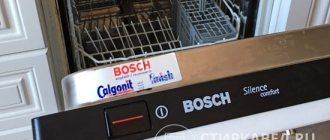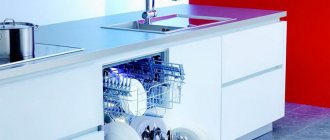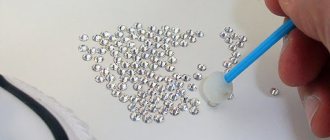For many years of trouble-free operation of a dishwasher (DMM), it is necessary to use not only washing powders, gels and rinse aids. The unit must be periodically refilled with regenerating salt. Each model has a special compartment for this chemical. Recommendations on how to choose a product, where and how much salt to pour into the dishwasher are standard for all appliances, regardless of brand and year of manufacture.
Why is salt needed?
Water used for drinking and domestic purposes always contains salts of dissolved alkaline earth metals - calcium and magnesium. The concentration of these compounds indicates increased or decreased water hardness: the higher it is, the harder the water flows from the tap and vice versa.
During the operation of technical devices, the operation of which is directly related to the heating of water, the formation of scale, limescale and deposits occurs. They worsen the technical characteristics of units and can lead to deformation and breakage of individual parts and assemblies.
To avoid such troubles, manufacturers have provided a special compartment - an ion exchanger, which contains a synthetic ion exchange resin. The purpose of this device is to soften water by attracting magnesium and calcium ions dissolved in water.
Passing through an ion exchanger, the water is completely purified from harmful impurities. But to restore the ion-exchange properties of the resin, the constant presence of sodium chloride is necessary, of which 98% consists of the regenerating salt for PMM. The remaining 2% are various chemical compounds intended to give the product a marketable appearance, disinfectant properties and aroma.
Salt softens water, prevents the formation of smudges, limescale and scale on the parts of the device, and extends the service life of the unit.
It makes it easier to wash out difficult stains from plates and glasses, ensuring the cleanliness and shine of washed dishes, which do not leave unsightly streaks and stains.
How is salt consumption related to water hardness?
To reduce water hardness, manufacturers included an ion exchanger in the PMM design. There is a resin inside that neutralizes all harmful impurities - when heating water, they can form a coating on the heating element and other parts. The simplest chemical reactions involving ions take place inside the ion exchanger - it is not necessary to thoroughly understand this, it is enough not to ignore the manufacturer’s instructions.
If water loses hardness when passing through an ion exchanger, why are additional products used? That’s why salt is called “regenerating” - it has the power to restore the balance of substances in the resin.
Methods for determining the degree of water hardness
There are several ways to determine hardness:
- With the naked eye. Take laundry soap and lather it on a piece of fabric (rag). If the fabric does not lather well and is difficult to rinse, the water is very hard.
- Observation. Observe how quickly plaque forms on faucets, plumbing fixtures, and other places that come into contact with tap water. With increased hardness, plaque quickly “sticks” to surfaces.
- Using a test strip. Accurate and fast option.
Attention! Hardness is a seasonal phenomenon. To get accurate results and calculate salt consumption, check once every 3-4 months.
- According to the regional hardness table. These tables are compiled by experts who classify water as soft, medium, hard and very hard.
Read more about the definition of rigidity in a separate article.
Is it easy to determine how often you need to add salt to the PMM? First, read the instructions for the technique - it describes the process in detail and step by step. So, for example, Bosch machines have up to 7 degrees of hardness for fine-tuning the equipment. When the salt supply is depleted, the control panel will turn on a red indicator. When using capsules, the light bulb is easy to turn off - so that it does not bother you, select one of the suggested hardness levels.
Even in Bosch brand machines (as well as Siemens or Electrolux (Electrolux)), setting the hardness to “0” does not always help to draw water bypassing the ion exchanger. If you ignore the manufacturer’s recommendations, do not buy salt, and use only tablets, the ion exchanger may become clogged with impurities coming from the water. This could result in serious equipment damage.
Using salt, you will not only get perfectly washed dishes and soften the water, but also protect the machine components from premature wear.
The purpose of dishwasher salt and its functions
container for specialized salt in the dishwasher
In most regions of the Russian Federation, hard water flows from taps, that is, with a high content of calcium and magnesium. And since the operation of the dishwasher is interconnected with the water supply, to prevent a number of unpleasant consequences, special salt should be poured into it.
Putting salt in the dishwasher is necessary to perform the following tasks:
- preventing the appearance of smudges and stains on washed dishes;
- ensuring the removal of limescale from glass and metal surfaces of plates and other kitchen utensils;
- softening hard water;
- this product prevents the formation of scale on the working parts of the dishwasher, which contributes to its breakdown;
- salt allows you to maintain the functioning of the ion exchanger, which is responsible for softening the water in the PMM, by replenishing the sodium supply.
Sodium is part of a synthetic resin that prevents calcium and magnesium from combining. The reaction of these two chemicals causes limescale deposits to form on surfaces.
At its core, special (regenerating) dishwasher salt is ordinary table salt consisting of sodium chloride (NaCl).
But one significant detail prevents it from being used as a water softener in the dishwasher. Regular salt contains a suspension , which can settle over time and crystallize in a tank for feeding it to the ion exchanger. And then prevent sodium-rich water from entering it. Therefore, excessive savings on professional products, which are usually sold in the form of granules cleared of impurities, can result in damage to household appliances.
To avoid scale formation on the heating element of household appliances - heating element, use only specialized salt for dishwashers.
How much to pour
The question of how much salt to pour into the dishwasher always worries those who start the machine for the first time. Manufacturers recommend a full load, that is, loading the bunker with salt to the top level. An average of 0.7 to 1.3 kg of softening component is placed in the compartment.
Judging by numerous user reviews, it is enough to fill a standard kilogram pack of salt once, and even with daily use of the PMM it will last for 1.5-3 months. The next filling of the softening agent must be carried out immediately after the no-salt indicator located on the digital display lights up.
How much salt is enough and how often you have to add it depends on the hardness of the water in the region. The easiest way to determine this is to call your local water and sewer company. The second accessible and more or less accurate way is to use a table or map of water hardness by region of Russia, compiled by specialists.
Salt consumption will be greater in the south and center of the European part of the country, as well as in the southern regions of Western Siberia. Residents of the northern European part of Russia and Eastern Siberia are luckier, since soft water flows from their taps in their homes.
Based on the results of determining water hardness, it is necessary to set the level of salt consumption.
Expensive branded models have a special sensor installed that automatically detects water hardness and adjusts the operation of the ion exchange device.
In budget machines, this function will have to be configured manually.
This procedure is described in detail in the dishwasher instructions and takes just a few minutes. Almost all models have a scale from 0 to 7, where 0 is super-soft water, and 7 is super-hard. By default, in most PMMs the hardness value is set to the middle position, but with the help of 2-3 buttons and a few clicks it can be easily changed up or down.
Forms of release of regenerating agents
Manufacturers of various products used in dishwashers produce universal dishwashing tablets - “10 in one”, “7 in one”, etc. Some of them contain a small amount of special salt. However, this amount is not enough to maintain normal sodium levels in the ion exchanger. The solution in this situation is obvious - add additional professional salt.
Like dishwashing detergents, manufacturers offer special salt in a variety of forms:
- Powdered or granular regenerating agents.
- Salt compressed into tablets.
When choosing a specific product, you need to be guided by the composition that the manufacturer indicates on the packaging of the regenerating salt. A smaller amount of various impurities and additives in it will give the most effective result.
Where to sleep
Before using the dishwasher for the first time, you should carefully study the instructions for using the unit. Manufacturers provide it with a detailed description of the technical characteristics, the device itself and the features of its operation.
Each unit has a special hole that opens the entrance to the salt bin. In dishwashers Bosch, Electrolux, Candy, Hotpoint-Ariston and other models of different price categories, the compartment is located at the bottom of the chamber under the lower container for dishes. The entrance to the ion exchange device is closed with a plastic screw cap, which must be unscrewed and returned to its place after adding the softener.
How to know when it's time to add
The easiest way is to watch the salt indicator light on the control panel of the device. It is marked with an S-shaped icon and usually looks as shown in the photo. On some brands, the PMM lights up in a very bright red color when activated, for example, on my Bosch, but in some copies the glow is dull, pale yellow and you need to take a closer look.
The indication is controlled by a special sensor. It is built into the machine’s ion exchanger and monitors the saturation of the saline solution. Triggers when the concentration decreases below the permissible values: an indicator lights up on the panel - a sign that there is little salt in the dishwasher, and until you add it, it will constantly glow.
What to do if there is no indicator
When there is no special light on the display, you will have to remember to refill yourself - write the date on a self-adhesive sticker and place it where the detergent is stored.
And also monitor the quality of the washed dishes. It's time to add salt when you notice one of the signs:
- Cloudy glass, whitish drops or milky residue on dishes. If this problem is eliminated by manual washing, it means that the saline solution in the softener is not concentrated enough, and the ion exchanger resin cannot be completely regenerated.
- Dishes do not come clean with multi-layer tablets. For hard water (above 21°dH) with combined detergents, you need to use salt - the one in the composition is not enough to soften.
It is the cleanliness of the plates and the shine of the glass that will tell you when it’s time to “add more salt” to your assistant. If there is an indicator, you also don’t have to wait for it to light up and add product if the quality of washing deteriorates. And with what frequency? Every month or once a year?
What does the manufacturer offer?
- A special product for restoring the ion exchanger - Finish, Calgonit, Somat or others.
- Tablet preparations - Topperr.
- Evaporated salt composition "Extra".
- Tablets based on "Extra".
Before using this or that product, be sure to read the instructions - usually the manufacturer indicates right on the packaging how much to put in the dishwasher.
How to choose
The range of dishwasher salts produced is large, so every consumer will be able to choose products to suit their taste and budget. The most popular variety is considered to be a granular (crystalline) product packaged in cardboard boxes or plastic bags. The drug with regenerating properties is produced by all leading manufacturers of household chemicals for PMM:
- Clean & Fresh.
- Gut & Günting.
- Elly.
- Finish.
- Kraft.
- Largo.
- Magic Power.
- O'Key.
- Paclan Brileo.
- Somat.
- Start.
- Sanit.
- Top House.
Product type and dosage
Before you decide on the amount you are going to pour into the PMM, you should choose what kind of salt you will use. There are 4 popular options:
- Special salt with regenerating properties. Produced under brands such as Finish, Somat, Calgonit, etc.
- Tablet version (for example, Topperr).
- Household substitute of the “Extra” variety (necessarily boiled). We wrote earlier about what else you can replace dishwasher salt with.
- Tablet "Extra".
The packaging of the purchased product contains instructions for use specifying the dosage. It also says that salt is poured into the bunker to the top. Since containers differ in volume in different dishwasher models, you may need less or more granules. The vast majority of models fit 2/3 of a pack weighing 1.5 kg.
Speaking of the usual food analogue, a standard pack weighing 1 kg will be enough for you. Salt tablets are also poured into the dishwasher to the top.
For owners of Bosch dishwashers
Let us give examples from the instructions for the Bosch brand PMM, from which it is clear that it is necessary to use salt.
Hardness reducing device
In order for the washing to take place at the proper level, purified water, without calcium salts, must be supplied to the machine. Otherwise, scale will appear on the walls, dishes and parts of the machine. Water with high calcium hardness must undergo a purification procedure before reaching important parts of the device. To soften the water, a device built into the body of the machine is used; salt is poured into it.
How and when to fall asleep
It is recommended to add salt before turning on the Electrolux machine. Adding water will help the substance dissolve faster, which will help improve dishwashing. When using tablets, they should be placed in the detergent compartment, which is most often located on the inside of the door.
Salt is always loaded before turning on the machine - this is necessary to protect against corrosion.
Do you need salt when washing with tablets?
If the region has low water hardness, it is possible to use combined tablets containing powder, rinse aid and regenerating crystals. In this case, the salt composition may not be added. But not everyone likes 3-in-1 products. When washing dishes with powder, salt is necessary.
Water of medium and high hardness cannot be used in PMM without special salt, regardless of the type of detergent.
For excellent cleaning results and proper functioning of the Bosch dishwasher, you need not only high-quality powder, but also a special salt composition. Timely replenishment of the reservoir with salt ensures uninterrupted operation of the equipment and frees the housewife from manual labor.
How to replace salt
Sometimes people, in order to save money, try to replace a specialized salt substance with a regular cooking mixture. However, not only will you not save money, but, on the contrary, you may even provide yourself with an additional expense item, since kitchen salt contains impurities that, when settled, can clog the internal mechanisms and parts of the dishwasher, which will subsequently lead to its breakdown. Compared to repair work, sodium chloride for dishwashers is not that expensive. Dishwasher detergent goes through several stages of cleaning, and its large particles are easy to use. Finely ground table salt does not have the properties that are so necessary when operating a dishwasher.
Consumables for PMM
When a kitchen assistant has been purchased, all that remains is to find out how to use its services correctly. Even the best dishwashers on the market - Bosch, Hansa, Electrolux, Ariston or Siemens - need care and will quickly fail if not used correctly. out of service. In order for them to work properly for a long time, they must be provided with:
- High-quality detergents. They are produced in the form of gels, powders and tablets. Rinse aids constitute a separate category - without them, stains and smudges will remain on the dishes. Tablet preparations can combine several functions at once - 3, 5, 10... There are tablets that are positioned as “all in one”.
- Salt - you will have to buy it separately if you use regular powders or gels for PMM. If the water is too hard, then even tablets that already contain salt components will not help - you still have to add salt.
What does salt contain?
Many people may think that dishwasher salt is almost the same as regular table salt, but this is not the case. First, dishwasher salt comes in larger granules. Secondly, such salt undergoes thorough purification, after which it simply cannot contain any impurities.
In addition, depending on the manufacturer, it can be made with the addition of the following components:
- Sodium citrate (serves to destroy germs and bacteria);
- Sodium percarbonate;
- Various flavoring agents;
- Sodium disilicate and bicarbonate;
- Sodium polyaspartate.
The above substances give the products of individual manufacturers distinctive properties. For example, some variations give water antibacterial properties or imbue it with a pleasant aroma.
What kind of salt for PMM is on the market?
You can put different types of salt compositions into the dishwasher - they differ in release form, price, and effectiveness. Among the proposed options, four are worth highlighting:
- Special salt compositions. Made for PMM. Brands Finish, Somat, Magic Power and others.
- Pills. For example, Topperr. Economical solution.
- Boiled salt "Extra". Inexpensive substitute for special equipment.
- "Extra" in tablets.
What can replace an expensive product?
These were just the most popular manufacturers of dishwasher salt. There are many more options on the market. But it is better to use the brands listed above, since other products may be of lower quality or not meet the stated standards. Now that we've sorted out the analysis of ordinary salts, let's talk about available analogues. There are only a few of them, most of them are sold in regular stores:
- First in line is salt from hardware stores. It is the best way to save money, since it is sold in large bags of 25-50 kilograms (perhaps there are smaller options, but this is the standard size). The price per kilogram is much lower than in supermarkets and grocery stores where table salt is sold, but such a product also has a small drawback - bulkiness. The packaging is inconvenient, and the tablets will have to be crushed into granules in order to put them in the dishwasher.
- Reactive salt or sodium chloride. This option may well be suitable for use, especially the “Chemical Pure” or “Special Purity” variations, but there are disadvantages everywhere. Here this is the structure, presented in the form of a powder, which will need to be granulated before being placed in the dishwasher.
- Table salt without iodine. This option is sold in every grocery store, but it is not very dishwasher safe. It has many disadvantages, for example, it is prohibited to use it when regenerating an ion exchange unit in a PMM. There are several reasons for this, the first is the high content of hardness salts, which contain calcium and magnesium, which negatively affects the resin. The second reason is the properties of the salt, which prevent rapid dissolution. Because of this, after a while, we will get salt lumps on the regeneration block and white powder, which will dissolve with great difficulty.
- Store-bought iodized salt. This option, unlike others, is prohibited. Resin is an excellent sorbent material for iodine, which means that over time it will be impossible to restore it.
It's best to use cheap substitutes only as a last resort, as dishwasher salt is better, more reliable, and safer for the cleaning process.
Tips for using salt
Some people make a number of mistakes when using dishwasher salt.
To avoid them, experts have identified a few simple tips that will help make dishes cleaner and also extend the life of the dishwasher:
- If your dishwasher has the ability to select water hardness, then you need to set the appropriate value. Some people do not pay attention to this function and set the value “to hell”, because they are simply too lazy to find out the hardness of the water they use. This leads to the appearance of scale on some parts of the dishwasher and impairs the cleaning of dishes;
- You only need to add salt when the corresponding indicator lights up. It is strongly not recommended to pour the product into the dishwasher;
- Do not pour regular detergent into the salt reservoir. This will lead to failure of the ion exchanger, the repair of which costs considerable money.
How much product is poured into the container?
How much salt to pour for the first time, when you first start the dishwasher, is determined by the design of the machine and the rules prescribed in its operating instructions. Usually this is about one kilogram of the substance. In the future, as the need arises, the dishwasher is replenished with approximately the same amount of salt product.
The influence of water hardness on product consumption
Water quality directly affects salt consumption. The more calcium, magnesium and other substances dissolved in water, the higher its hardness and the more intense the consumption of saline solution to soften the water. Water hardness can be determined using special test strips. These test strips are usually purchased at pet stores or hardware stores. In addition, it is possible to order a water analysis at the SES or at any suitable laboratory - this guarantees an accurate result, but you will have to spend time and money.
Having determined the hardness level, you will need to configure the water softener (ion exchanger) in the PMM, setting the appropriate hardness value. Budget models or compact devices with limited functionality may not have this function. In this case, the effectiveness of using salt products may simply decrease, but the effect of their use itself will not disappear.











